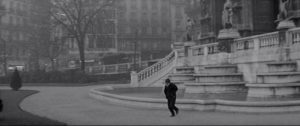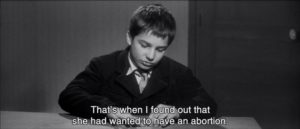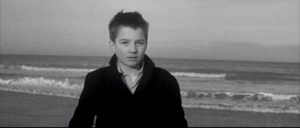I would consider my parents to have been pretty lenient while I was growing up. When I did get in trouble, it wasn’t more than a night’s grounding, or my phone would be taken away for a few hours. Such minor consequences like those derived from love and care, not out of spite. They wanted to help me develop my morals, which made me the person I am today. On the other hand, François Truffaut experienced a very different childhood. He used his 1959 semi-autobiographical film, Le Quatre Cent Coups, or its English translation, The 400 Blows, as a window into what his adolescence was like. By replicating his childhood as he remembers it, we see the harmful effects of neglectful parents. Truffaut used his own struggles and turned them into a touching memoir that is also a reminder to all parents to love your child no matter the circumstances.
Truffaut was born in 1932 from a mother who was only seventeen years old, Janine de Montferrand. Being seventeen, she did not want a child and passed him onto a wet nurse. Truffaut was then passed onto his grandmother but returned to his mother and her newlywed husband, Roland Truffaut, after his grandmother’s death in 1940. Truffaut spent most of his time outside of the house, ‘raising hell’, if you will. This is where he got the idea for the title of the film. There is a French idiom that goes, “Faire les quatre cents coup,” which roughly translates to “to raise hell.” Although the film’s title alludes to the idea of delinquent activities, and while most of the film shows Antoine performing those activities, it also signifies a metaphor for “the 400 blows” to a child’s psychological state with neglectful parents, having to grow up on their own as Truffaut did.
The 400 Blows is the first of five films that follow Truffaut’s counterpart Antoine Doniel, played by Jean-Pierre Leaud, and his life as he grows up. The series is called The Adventures of Antoine Doniel. In Issue two, I will be covering another episode in the series called, Antoine and Colette. Instead of neglectful parents, Antoine struggles with a desultory crush. It seems like he can never catch a break.
Truffaut wrote the script for The 400 Blows mainly based on his own life but adapted parts of it for the screen. For instance, Truffaut would skip school every so often, but he would mostly go to see a film or read Balzac in the library instead of going to arcades or fair rides like Antoine. At the least, you can’t say he wasn’t being productive with his time. If you’re unfamiliar with Balzac like I was when I first saw his name, he was a French playwright and novelist renowned for his realism based on French society. Contrarily, he made sure his characters and objects in his novels were complicated and compelling. By using the juxtaposition between the two, he was able to write captivating and exciting books, and was a considerable influence on Truffaut. Truffaut even pays tribute to him in the film by having Antoine read his book for inspiration and making a little shrine. Unfortunately, it catches fire and doesn’t help his case as a delinquent child.

Antoine’s Shrine to Balzac.
Now, getting to the film itself, Le Quatre Cent Coups starts out with some of the boys in Antoine’s class passing around a calendar of a woman wearing seductive clothing. It gets passed through several of them, but when it comes to Antoine, the teacher finally notices, and he is the one to get in trouble. This first scene is an excellent example of techniques used during the movement. Instead of several short clips, the camera is positioned in the back of the room and uses one long take–about a minute long–to show events’ progression. The “fly on the wall” style was standard in French New Wave films and let us feel like we were experiencing what it would be like to be in that situation. Taking one long shot without messing up is not always easy to do, either. Think of all the mess-ups and bloopers that can happen within a seven-second scene – so to accomplish so many long takes within a film is quite a feat. The set and most of the film was shot on location in Paris, France, which added the perfect touch to make his semi-autobiography more authentic. Shooting on location was another technique that was popular among French New Wave films. I have been to France twice, and I can definitely say that if I were to be a filmmaker in Paris, I would take every opportunity to use the gorgeous scenery instead of a sound stage. Truffaut applies a few wide shots throughout the film to really capture the beauty of the city and its occupants, who look just as perfect.

Wide shot of Antoine running through a beautiful park.
On the other hand, Antoine has some notable qualities that make him stand out compared to Paris’s picture-perfect citizens. Compared to many of the others wearing long coats of solid colors, he is wearing a checkered jacket. His friend, René Bigey, who is played by Patrick Auffy, and Antoine seem to be the only children out and about, making them more noticeable as well. In my opinion, Antoine doesn’t look entirely out of place, so to speak. The small details like his jacket could be Truffaut’s way of portraying what he felt in a tangible way that’s easier for the audience to pick up on without directly having Antoine express his ambivalence. Focus on mise-en-scene was very important during this era of film as well. Since many of the narratives didn’t always have a linear story, being able to portray meaning in other ways was vital.

Antoine’s checkered jacket.
Eventually, towards the end of the film, Antoine is sent to an observational center after stealing his father’s typewriter. There, he talks with a psychologist. However, we do not see the psychologist, only Antoine does. By having the focus solely on Antoine while he reveals all his life problems, it re-iterates how he might have felt alone and isolated from others. The film never explains to us why Antoine misbehaves until this moment. He reveals that he knew that his mother didn’t like him based on many of the things she did. For instance, he overheard his mother say she wanted to have an abortion, she would scavenge through his pockets all of the time, sell his personal objects, and yell at him for no reason. With this in mind, it puts into perspective why Antoine acts the way he does. Even if his actions were short term, his parents’ mistreatment, and especially by his mother, have long-lasting effects. Finally, Truffaut did get a chance to extinguish any fires put between him and his mother by showing her how he felt. At the very least, he was able to release some of his anguish.

Antoine talking with the therapist.
After Antoine is done talking with the psychologist, he runs away to the sea, which he had mentioned earlier he had never seen before. He runs for what seems like miles without stopping until he finally reaches the shoreline. There, he steps in the water and looks a little underwhelmed, looking directly into the camera when the video freezes, zooming in on his disappointed face. The sea seems to wash away his footprints signaling a new start for Antoine, but when adding the freeze frame to the end, it cuts the film’s continuity. This frame brings back the idea that everything he has done can’t be erased, even if he’s willing to turn a new leaf. This ending sparks questions such as, ‘what is Antoine going to do now?’ ‘What punishment awaits him?’ Truffaut leaves it up to the viewer to imagine the next scenario. Still, based on how his previous penalties went, the thought lingers in our mind, questioning our own childhood and our future, or current parental guidance.

Antoine’s face at the end of the film.


Recent Comments